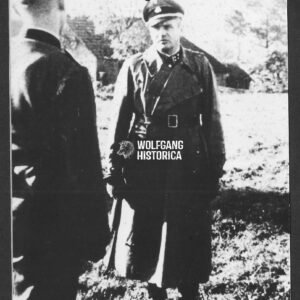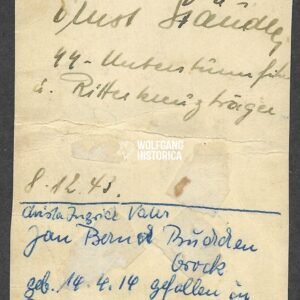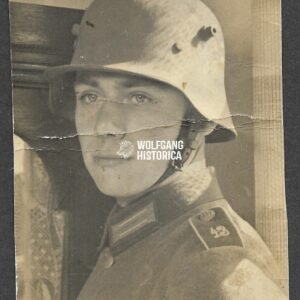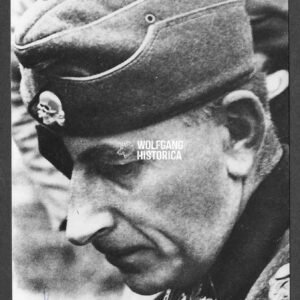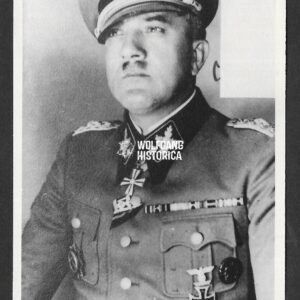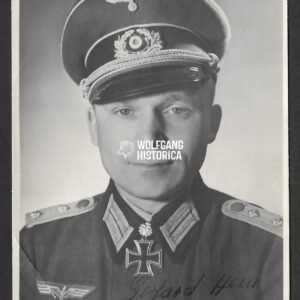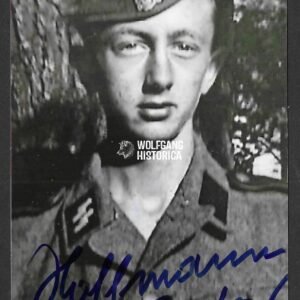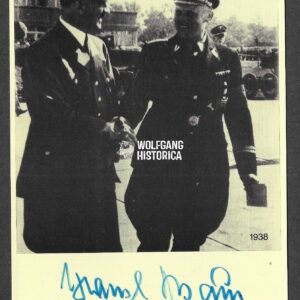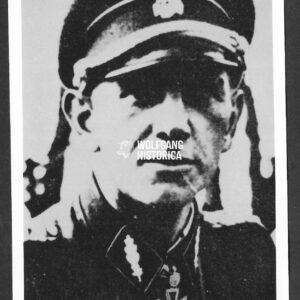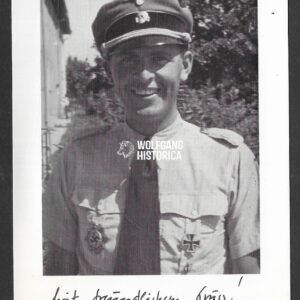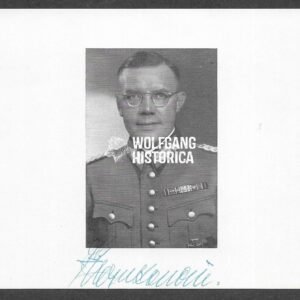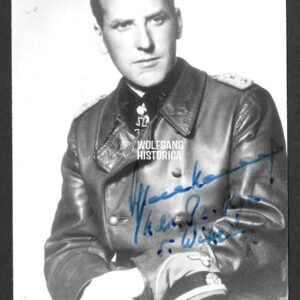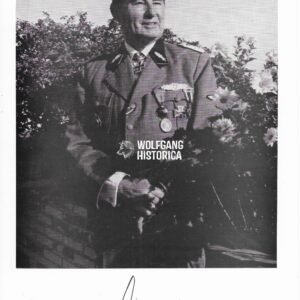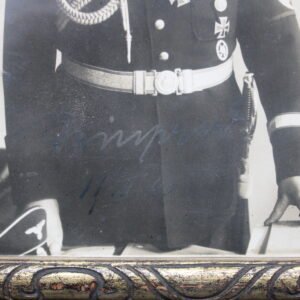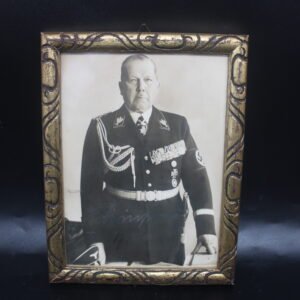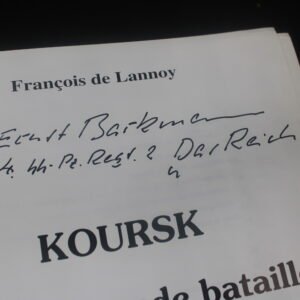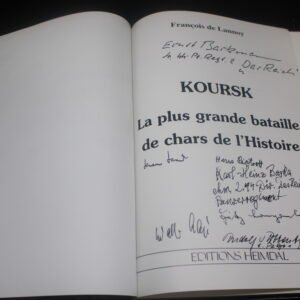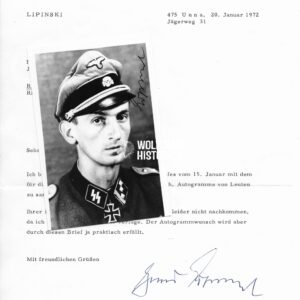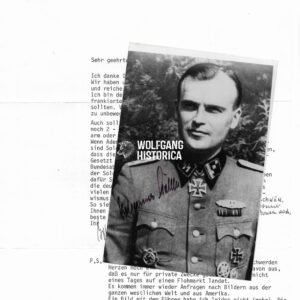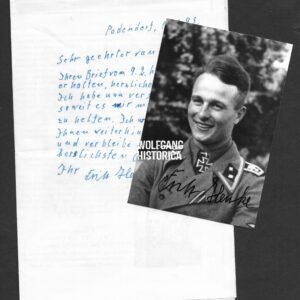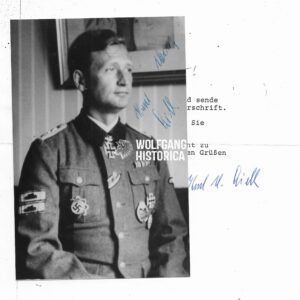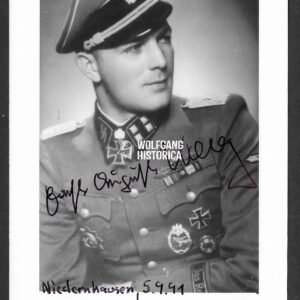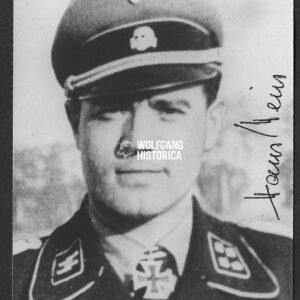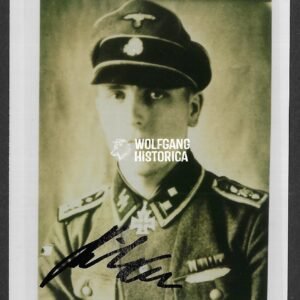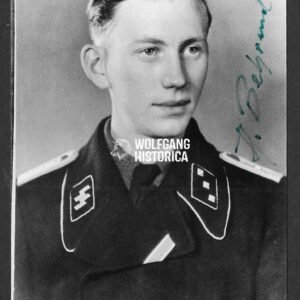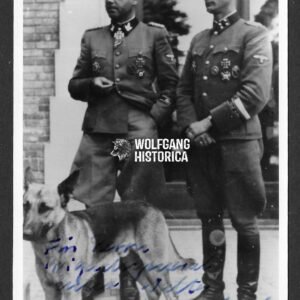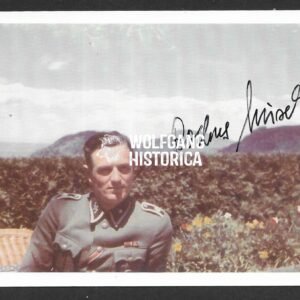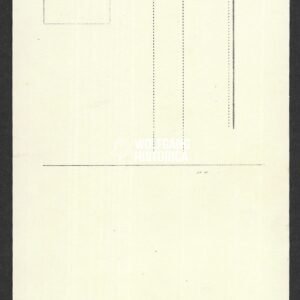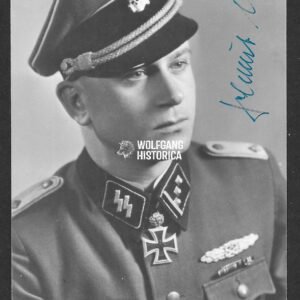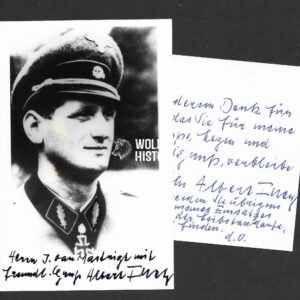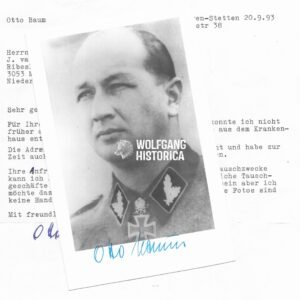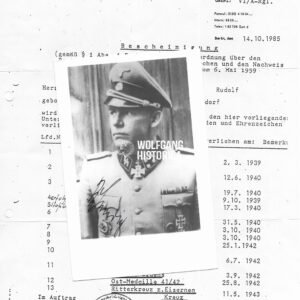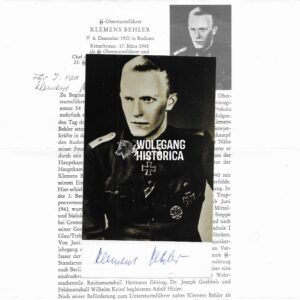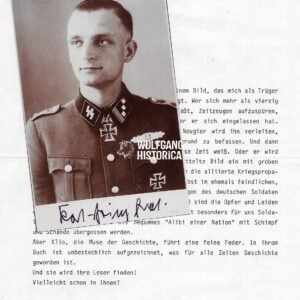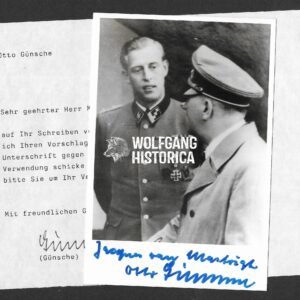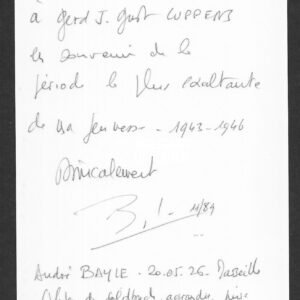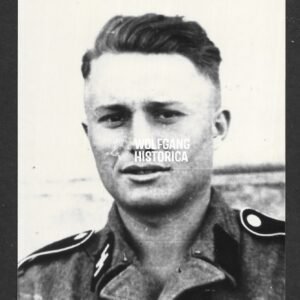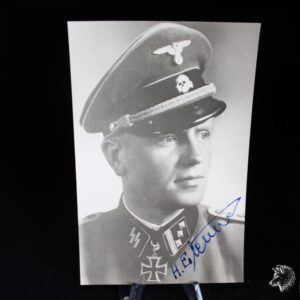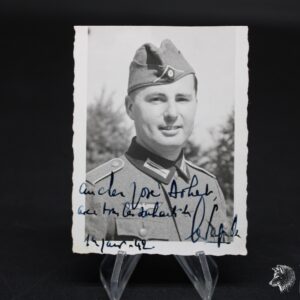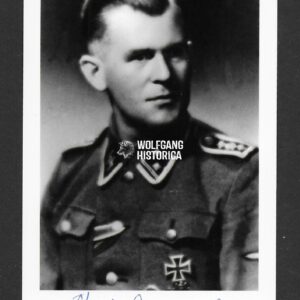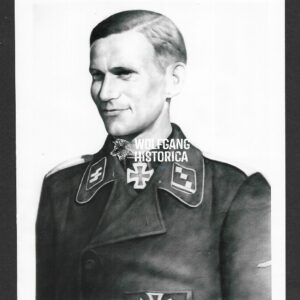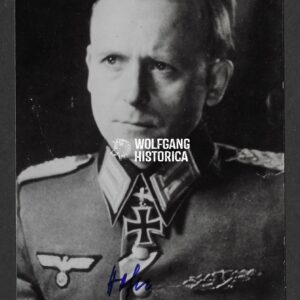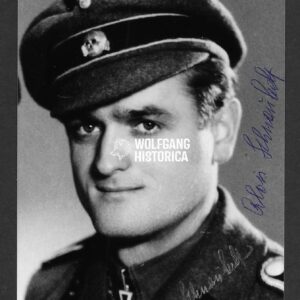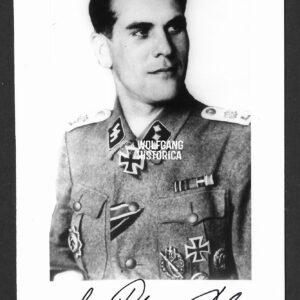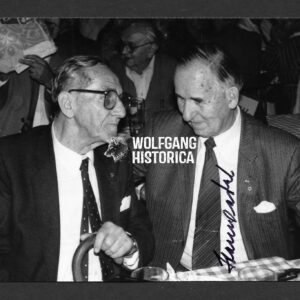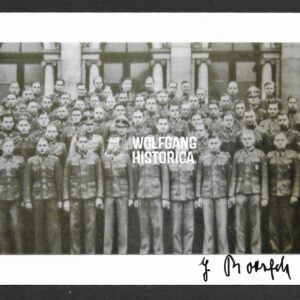Customers facing issues ordering, contact me
via info@wolfganghistorica.com or wolfganghistorica@gmail.com
NEW HOUTEN MILITARIA FAIR VIDEO ONLINE: Watch it here!
Paul Egger – schwere SS-Panzer-Abteilung 502
€45,00Original Postwar Signature on a Postwar Photo of Paul Egger. SS-Obersturmführer Paul Egger (26 November 1916 – 12 July 2007) was a decorated Waffen-SS panzer officer and late-war tank ace credited with 113 confirmed tank kills.
-
Deutsches Kreuz in Gold – 30 December 1944, as Zugführer in schwere SS-Panzer-Abteilung 502.
-
Ritterkreuz des Eisernen Kreuzes – 28 April 1945, as SS-Obersturmführer und Kompaniechef of 1./schwere SS-Panzer-Abteilung 502.
Career Highlights:
-
Early Service: Joined the Waffen-SS in 1941, assigned to SS-Panzer-Regiment 2 “Das Reich” as a tank commander.
-
Normandy Battles: Fought with schwere SS-Panzer-Abteilung 102 during the Battle of Normandy, where the unit was almost completely destroyed.
-
Eastern Front Actions: Reformed as schwere SS-Panzer-Abteilung 502, Egger took part in the brutal defensive battles around Stettin in 1945.
-
Tank Ace: Credited with 113 destroyed enemy tanks, making him one of the more successful SS panzer commanders of the late war period.
Item Details:
-
Format: Postwar photograph, postcard size.
-
Signature: Authentic postwar autograph of SS-Obersturmführer Paul Egger.
-
Condition: Very good, clean and well-preserved.
Collector’s Note:
Paul Egger’s significance lies in his service with both Das Reich and the schwere SS-Panzer-Abteilungen, two of the most well-known Waffen-SS armored units. His high kill record and late-war Knight’s Cross award make his autograph particularly sought after. This example represents a scarce and desirable set for collectors of panzer aces and Waffen-SS memorabilia.
Leon Degrelle – 28. SS-Freiwilligen-Panzer-Grenadier-Division “Wallonië”
€250,00SS-Standartenführer Leon Degrelle (15 June 1906, Bouillon † 31 March 1994, Málaga) was the Belgian leader of the Rexist Movement and one of the most famous foreign volunteers to serve in the Waffen-SS during the Second World War. He rose from enlisted service to command the Walloon volunteers on the Eastern Front, eventually leading the 28. SS-Freiwilligen-Grenadier-Division “Wallonien.”
Degrelle distinguished himself in heavy fighting against Soviet forces, receiving some of the highest decorations awarded to non-German volunteers. He survived the war, escaping to Spain where he lived in exile until his death in 1994.
Awards and Decorations
-
Knight’s Cross of the Iron Cross (Ritterkreuz des Eisernen Kreuzes) – 20 February 1944, as SS-Hauptsturmführer and Führer of 5. SS-Freiwilligen-Sturmbrigade “Wallonien.”
-
Oak Leaves to the Knight’s Cross (Eichenlaub) – 27 August 1944, as SS-Sturmbannführer and Kommandeur of 28. SS-Freiwilligen-Grenadier-Division “Wallonien.”
-
Close Combat Clasp in Gold (Nahkampfspange in Gold) – 14 September 1944.
-
Additional decorations included the Iron Cross 1st and 2nd Class and Infantry Assault Badge.
Item Details
-
Authentic scarce postwar signature of Leon Degrelle.
-
Signed on a large format postwar photo
-
Condition: As seen – scarce and collectible.
Collector’s Note
Leon Degrelle remains one of the most controversial and well-known foreign volunteers of the Waffen-SS. His rise from volunteer soldier to divisional commander, along with his postwar exile and continued notoriety, makes his autograph especially rare and sought-after. This large-format signed photo is an exceptional piece for advanced collectors of Waffen-SS history, foreign volunteer units, and Knight’s Cross recipients.
Ernst Barkmann – SS-Panzer-Regiment 2 “Das Reich” (Normandy)
€60,00SS-Oberscharführer Ernst Barkmann (25 August 1919, Kisdorf † 27 June 2009, Kisdorf) was a Waffen-SS NCO and tank commander in the 2. SS-Panzer-Division “Das Reich.” He became one of the division’s most famous Panzer aces and was decorated for his actions in Normandy during the summer of 1944.
Barkmann received the Knight’s Cross of the Iron Cross (Ritterkreuz des Eisernen Kreuzes) on 27 August 1944 as SS-Unterscharführer und Panzerkommandant in the 4./SS-Panzer-Regiment 2. His most renowned action, often referred to as “Barkmann’s Corner,” took place near Le Lorey, where his Panther tank reportedly destroyed numerous Allied vehicles in a single engagement, halting an American advance.
Awards and Decorations
-
Knight’s Cross of the Iron Cross (Ritterkreuz des Eisernen Kreuzes) – 27 August 1944, as SS-Unterscharführer und Panzerkommandant, 4./SS-Panzer-Regiment 2, 2. SS-Panzer-Division “Das Reich.”
-
Other wartime decorations included the Iron Cross 1st and 2nd Class, Panzer Badge in Silver, and the Wound Badge.
Item Details
-
Authentic postwar signature of SS-Oberscharführer Ernst Barkmann.
-
Signed on a postwar photograph.
-
Size: Postcard format.
-
Condition: As seen, well-preserved autograph.
Collector’s Note
Ernst Barkmann’s reputation as a Panzer ace of the Waffen-SS, particularly tied to the legendary events at “Barkmann’s Corner,” makes his signature highly sought after among collectors of armored warfare memorabilia and Knight’s Cross recipients. Postwar signed photographs of Barkmann are increasingly scarce and represent an important piece of history from the Normandy campaign and the Das Reich Division.
Walter Harzer – 9. SS-Panzer-Division “Hohenstaufen” (Arnhem)
€150,00Original Scarce Postwar Signature on a Postwar Photo of Walter Harzer. SS-Standartenführer Walter Harzer (29 September 1912, Landau an der Isar † 29 May 1982, Stuttgart) was a Waffen-SS officer who rose to the rank of SS-Standartenführer during the Second World War. A staff-trained officer, he is best remembered for his role as Ia (operations officer) of the 9. SS-Panzer-Division “Hohenstaufen” during the Battle of Arnhem in September 1944, where he earned the Knight’s Cross of the Iron Cross.
Award:
-
Knight’s Cross of the Iron Cross (Ritterkreuz des Eisernen Kreuzes) – 21 September 1944, as SS-Obersturmbannführer and Ia of 9. SS-Panzer-Division “Hohenstaufen”, for his decisive role in repelling British airborne forces during Operation Market Garden (Arnhem).
Career Highlights:
-
Joined the SS in the prewar years and advanced as a staff officer within the Waffen-SS.
-
As operations officer of 9. SS-Panzer-Division “Hohenstaufen”, played a central part in organizing the German defense during the Battle of Arnhem, contributing to the failure of the British 1st Airborne Division’s attempt to hold the Arnhem bridgehead.
-
For his performance at Arnhem, awarded the Knight’s Cross, one of the few operations officers to receive the decoration.
-
Later rose to SS-Standartenführer, continuing his service with Waffen-SS formations until the end of the war.
-
After the war, lived quietly in West Germany until his death in 1982.
Item Details:
-
Authentic scarce postwar signature of SS-Standartenführer Walter Harzer.
-
Signed on a postwar photograph.
-
Condition: As seen, with clear autograph.
Heinz Harmel – “Deutschland” & “Frundsberg” (Schwertern) (Normandy, Nijmegen) (Large Size!)
€125,00Original Postwar Signature on a Postwar Photo of Heinz Harmel. SS-Brigadeführer und Generalmajor der Waffen-SS Heinz Harmel (29 June 1906, Metz, Alsace-Lorraine † 2 September 2000, Krefeld) was a Waffen-SS officer who rose to the rank of SS-Brigadeführer und Generalmajor der Waffen-SS. Best known for his front-line leadership, Harmel commanded SS-Panzergrenadier-Regiment 3 “Deutschland” and later the 10. SS-Panzer-Division “Frundsberg”, earning the Ritterkreuz des Eisernen Kreuzes with Oak Leaves and Swords.
Awards and Decorations
-
Knight’s Cross of the Iron Cross (Ritterkreuz des Eisernen Kreuzes) – 31 March 1943, as SS-Obersturmbannführer and Kommandeur SS-Panzergrenadier-Regiment 3 “Deutschland”
-
Oak Leaves (Eichenlaub, 296th Award) – 7 September 1943, as SS-Standartenführer and Kommandeur SS-Panzergrenadier-Regiment 3 “Deutschland”, 2. SS-Panzer-Division “Das Reich”
-
Swords (Schwerter, 127th Award) – 15 December 1944, as SS-Brigadeführer und Generalmajor der Waffen-SS and Kommandeur 10. SS-Panzer-Division “Frundsberg”
Career Highlights
-
Early service: Joined the Waffen-SS and quickly rose through the ranks, noted for his competence and ability to inspire troops in combat.
-
Eastern Front: Gained distinction as Kommandeur of SS-Panzergrenadier-Regiment 3 “Deutschland”, earning both the Knight’s Cross and the Oak Leaves for his leadership in heavy fighting.
-
Western Front 1944: As commander of the 10. SS-Panzer-Division “Frundsberg”, Harmel led his division in the Normandy battles, the defense of Arnhem during Operation Market Garden, and the Alsace and Ardennes campaigns.
-
End of the war: In 1945, his division fought in Saxony and Czechoslovakia. Harmel surrendered to Allied forces in May 1945 and was held as a POW.
-
Postwar life: Released after the war, Harmel lived a quiet life in Krefeld until his death in 2000 at the age of 94.
Item Details
-
Authentic postwar signature of Heinz Harmel, SS-Brigadeführer und Generalmajor der Waffen-SS.
-
Signed on a large postwar photograph.
-
Condition: Very good, clear autograph and well-preserved photo.
Collector’s Note
Heinz Harmel’s career spans some of the most decisive campaigns of WWII, from the Eastern Front to Normandy and Arnhem. His receipt of the Knight’s Cross with Oak Leaves and Swords, combined with his leadership of the 10. SS-Panzer-Division “Frundsberg”, places him among the notable Waffen-SS divisional commanders. His long postwar life and willingness to sign autographs make his signature obtainable, but pieces on large-format photos such as this are scarcer and highly desirable for collectors.
Ernst Stäudle – SS-Artillerie-Regiment “Totenkopf” (Wartime Signed)
€250,00Original Wartime Signature on a Wartime Photo of Ernst Stäudle. SS-Obersturmführer Ernst Stäudle (6 June 1913, Heidenheim an der Brenz † 11 July 1946, POW camp Jaworzno, Silesia) was a Waffen-SS officer who served with the SS-Division “Totenkopf” and rose to the rank of SS-Obersturmführer der Reserve. He was a decorated front-line artillery observer and one of the division’s Knight’s Cross recipients. His actions during the bitter fighting near Schumilkino in February 1942 earned him the Ritterkreuz des Eisernen Kreuzes, awarded on 10 April 1942.
Awards and Decorations
-
Ehrendegen des Reichsführers-SS
-
SS-Ehrenring
-
Julleuchter der SS
-
Knight’s Cross of the Iron Cross (Ritterkreuz des Eisernen Kreuzes) – 10 April 1942, as SS-Oberscharführer der Reserve and Forward Observer, 8./SS-Artillerie-Regiment “Totenkopf”
-
Golden Hitler Youth Honour Badge with Oakleaves
Knight’s Cross of the Iron Cross (Ritterkreuz des Eisernen Kreuzes)
“SS-Oberscharführer Stäudle was in position on the night of 26th and 27th of February 1942, fighting near Schumilkino. He was a forward observer, directing the fire of his artillery battery against an enemy attack advancing from the west, supported by artillery and mortars. During the course of the attack, Soviet forces succeeded in approaching the village with around 50 men. From our own forces, only a handful of weakened defenders held the sector.
These men resisted the Soviets with the determination of a battalion and succeeded in putting them to flight.
In this critical situation, and despite suffering from a severe wound, Stäudle ordered the remaining men to continue the defense, employing their 3.7 cm Flak gun at close range. By halting this attack, Soviet operational plans were disrupted, and their troops arrived in Salutschje piecemeal.
I request the award of the Knight’s Cross of the Iron Cross in recognition of his successful and decisive actions.”
Career Highlights
-
Joined the SS in the 1930s, following early service in the Hitlerjugend.
-
Served as Forward Observer (Vorgeschobener Beobachter) in 8./SS-Artillerie-Regiment “Totenkopf” during the Demjansk Pocket battles.
-
Ritterkreuz award action: On 26/27 February 1942, during heavy Soviet attacks near Schumilkino, Stäudle, though severely wounded, rallied a handful of defenders and with only a 3.7 cm Pak 36, held off Soviet forces at close range, preventing a breakthrough behind German positions at Salutschje.
-
Later became an instructor at the SS-Artillerie-Schule II in Beneschau, before returning to action in April 1945 during the fighting around Prague, commanding a company.
-
Captured by the Soviets in May 1945 and sent to the notorious Jaworzno POW and forced-labor camp, where he died on 11 July 1946 from mistreatment and starvation.
Item Details
-
Authentic historical background of SS-Obersturmführer Ernst Stäudle.
-
Served in one of the most heavily engaged Waffen-SS divisions of the Eastern Front.
-
Condition of historical record: Detailed wartime service, well-documented Knight’s Cross recommendation.
- Condition as seen - written on reverse of a smaller size photo of him in the Reichwehr.
Collector’s Note
Ernst Stäudle’s name is closely tied to the SS-Totenkopf-Division’s fighting in Demjansk. His Ritterkreuz award, earned under extreme circumstances with minimal resources, highlights the brutal reality of the Eastern Front. His tragic death in Soviet captivity at Jaworzno, one of the harshest postwar camps, adds historical poignancy. Stäudle’s story embodies both the celebrated and catastrophic aspects of Waffen-SS service, making related autographs, photos, or documents significant for collectors focusing on Demjansk Shield recipients, Totenkopf Division history, or Knight’s Cross holders.
Paul “Papa” Hausser – SS-Oberst-Gruppenführer (Schwertern)
€150,00Original Postwar Signature on a Postwar Photo of Paul “Papa” Hausser. SS-Oberst-Gruppenführer und Generaloberst der Waffen-SS Paul Hausser
(07 October 1880, Brandenburg an der Havel † 21 December 1972, Ludwigsburg), nicknamed “Papa Hausser”, was one of the most senior and influential commanders of the Waffen-SS. A career Prussian officer and veteran of the First World War, Hausser played a pivotal role in shaping the Waffen-SS into an effective military arm. During the Second World War, he rose to the rank of SS-Oberst-Gruppenführer und Generaloberst der Waffen-SS, commanding divisions, corps, and ultimately entire armies on both the Eastern and Western Fronts.
Awards and Decorations
-
Knight’s Cross of the Iron Cross (Ritterkreuz des Eisernen Kreuzes) – 8 August 1943, as SS-Gruppenführer und Kommandeur of the SS-Division “Das Reich”.
-
Oak Leaves to the Knight’s Cross (Eichenlaub) – 28 July 1943, as SS-Obergruppenführer und Kommandierender General of II. SS-Panzer-Korps.
-
Swords to the Knight’s Cross (Schwerter) – 26 August 1944, as SS-Oberst-Gruppenführer und Oberbefehlshaber of 7. Armee, awarded for his leadership during the Battle of Normandy.
Career Highlights
-
First World War: Served as a Prussian officer, heavily decorated for bravery.
-
Interwar Period: Retired Reichswehr officer who later joined the SS and became one of its first senior military leaders.
-
Commander of SS-Division “Das Reich”: Distinguished himself on the Eastern Front, earning the Knight’s Cross.
-
II. SS-Panzer-Korps: Successfully led Waffen-SS panzer formations in major battles, including Kursk and Kharkov.
-
Battle of Normandy (1944): As commander of the 7. Armee, he attempted to stabilize the German front during the Allied invasion of France.
-
Postwar Years: Captured and later released, Hausser became the first spokesman of HIAG, the Waffen-SS veterans’ organization, and authored books defending the military record of the Waffen-SS.
Item Details
-
Authentic postwar signature of SS-Oberst-Gruppenführer und Generaloberst der Waffen-SS Paul “Papa” Hausser.
-
Signed on a postwar photograph.
-
Size: Postcard format.
-
Condition: As seen.
Collector’s Note
Paul Hausser remains a central and controversial figure in the history of the Waffen-SS. His postwar writings and role in veterans’ advocacy shaped much of the early narrative about the Waffen-SS in Germany. As one of the very few Waffen-SS leaders to reach the rank of Generaloberst, his autograph is a highly desirable addition for collectors focusing on SS high command, Knight’s Cross with Oak Leaves and Swords recipients, and Normandy campaign memorabilia.
Karl-Maria Demelhuber – Befehlshaber der Waffen-SS in den Niederlanden
€165,00Original Scarce Postwar Signature on a Postwar Photo of Karl-Maria Demelhuber. SS-Obergruppenführer und General der Waffen-SS Karl-Maria Demelhuber
(27 May 1896, Freising – 18 March 1988, Seeshaupt, Bavaria) was a senior Waffen-SS officer who rose to the rank of SS-Obergruppenführer und General der Waffen-SS during the Second World War. A career officer, he held a series of high-level commands including the SS-Standarte “Germania”, the 6. SS-Gebirgs-Division “Nord”, and later the XII. and XVI. SS-Korps. His wartime service placed him among the key organizational leaders of Waffen-SS formations, particularly in the Netherlands and on secondary fronts.
Awards and Decorations
-
German Cross in Silver (Deutsches Kreuz in Silber) – 9 November 1943, as SS-Gruppenführer und Generalleutnant der Waffen-SS, Befehlshaber der Waffen-SS in den Niederlanden
-
Other decorations included the Iron Cross (WWI & WWII) and long-service awards of the SS and Wehrmacht
Career Highlights
-
Early SS Leadership: Commanded the SS-Standarte “Germania”, one of the formative regiments of the Waffen-SS.
-
Mountain Division Command: Led the 6. SS-Gebirgs-Division “Nord”, a unit that saw action in Finland and northern theaters.
-
Higher SS Corps Commands: Later commanded the XII. SS-Korps and the XVI. SS-Korps, overseeing Waffen-SS formations in the later stages of the war.
-
Occupation Duties: Served as Befehlshaber der Waffen-SS in the Netherlands, where he was awarded the German Cross in Silver for his role.
-
Postwar: Captured and interned after 1945, Demelhuber lived quietly in Bavaria until his death in 1988.
Item Details
-
Authentic scarce postwar signature of Karl-Maria Demelhuber.
-
Postcard size format.
-
Condition: Good, clear and well-preserved autograph.
Collector’s Note
Demelhuber’s signature is regarded as scarce, given his relatively low postwar profile and limited correspondence compared to other high-ranking SS generals. His career—spanning from regimental leadership with “Germania” to corps command in the final stages of the war—makes his autograph a significant addition for collectors focused on the leadership structure of the Waffen-SS and the history of its major divisional commanders.
Gerhard Hein – Infanterie-Regiment 209 (Eichenlaub) (12. SS-Panzer-Division “Hitlerjugend”)
€150,00Original Wartime Signature on a Postcard of Gerhard “Gerd” Hein. SS-Sturmbannführer & Oberstleutnant der Reserve Gerhard Hein (9 July 1916, Klein Paniow-Rybnik † 6 June 2008, Harrislee) was a German officer who served with distinction on the Eastern Front and later with the Waffen-SS. He was a Knight’s Cross with Oak Leaves recipient and rose to command the SS-Panzergrenadier-Regiment 26 of the 12. SS-Panzer-Division “Hitlerjugend.”
Awards and Decorations
-
Knight’s Cross of the Iron Cross (Ritterkreuz des Eisernen Kreuzes) – 3 September 1940, as Unteroffizier and platoon leader, 10./Infanterie-Regiment 209, 58. Infanterie-Division.
-
Oak Leaves to the Knight’s Cross (Eichenlaub zum Ritterkreuz) – 6 September 1942, as Leutnant and company commander, 5./Infanterie-Regiment 209, 58. Infanterie-Division.
Career Highlights
-
Distinguished himself early in the war, earning the Knight’s Cross as a platoon leader in 1940.
-
Awarded the Oak Leaves for continued leadership and bravery in 1942 on the Eastern Front.
-
Later transferred to the Waffen-SS, where he became commander of SS-Panzergrenadier-Regiment 26 of the elite 12. SS-Panzer-Division “Hitlerjugend.”
-
Rose to the rank of SS-Sturmbannführer in the Waffen-SS and Oberstleutnant der Reserve in the Heer.
-
Survived the war and lived until 2008, passing away in Harrislee.
Item Details
-
Original Wartime signature of Gerhard Hein.
-
Signed on a Wartime Postcard.
-
Condition: Clear and well-preserved autograph.
Collector’s Note
Hein’s dual career in both the Heer and Waffen-SS, combined with his Knight’s Cross with Oak Leaves, makes him a particularly interesting figure. His command of the Hitlerjugend Division’s SS-Panzergrenadier-Regiment 26 places him among the most notable regimental leaders of the Waffen-SS. His long postwar life and rarity of signed material enhance the value of his autograph for collectors of Knight’s Cross holders and Waffen-SS memorabilia.
Gustav Hoffmann – SS-Flak-Abteilung 12 “Hitlerjugend”
€35,00Original Postwar Signature on a Postwar Photo of Gustav Hoffmann. SS-Sturmmann Gustav Hoffmann (16 January 1926, Vienna † 24 October 2024) served as an SS-Sturmmann in the 4. Batterie/SS-Flak-Abteilung 12 of the 12. SS-Panzer-Division “Hitlerjugend.” Born the son of deaf parents and raised in modest conditions, he completed school and training as an office clerk before volunteering in 1943 for service with the Waffen-SS.
He began his duty on 22 August 1943 at the SS-Flak-Ausbildungs- und Ersatz-Regiment in München and was later transferred to the 4. Batterie/SS-Flak-Abteilung 12. There, Hoffmann served as a driver for the Sd.Kfz. 7/2 halftrack with its mounted 3.7 cm Flak gun. He took part in the bitter fighting in Normandy, the Ardennes, and Hungary. At war’s end, he was captured by American forces in Austria and spent time in U.S. captivity.
In the postwar years, Hoffmann preserved and collected accounts, diaries, and reports from his comrades of the 4. Batterie, culminating in the publication of the detailed unit chronicle “In Erdkampf und Luftabwehr,” which appeared in 2020.
Awards & Service Notes:
-
Rank: SS-Sturmmann
-
Unit: 4. Batterie/SS-Flak-Abteilung 12, 12. SS-Panzer-Division “Hitlerjugend”
-
Role: Driver of Sd.Kfz. 7/2 halftrack with 3.7 cm Flak gun
-
Campaigns: Normandy, Ardennes, Hungary
Item Details:
-
Authentic postwar signature of Gustav Hoffmann.
-
Signed on a postwar photograph (postcard size).
-
Condition: Very good, crisp autograph.
Collector’s Note:
Hoffmann lived to the age of 98, passing away in October 2024. As one of the last veterans of the 12. SS-Panzer-Division “Hitlerjugend,” his personal recollections and his chronicle work provide a rare perspective on this infamous Waffen-SS unit. His signed photo represents a scarce opportunity for collectors of Waffen-SS autographs and unit history.
Hans Baur – Personal Pilot of Adolf Hitler
€75,00Original Postwar Signature on a Postwar Photo of Hans Baur. SS-Gruppenführer Hans Baur (14 June 1897, Ampfing † 17 February 1993, Herrsching am Ammersee) was a German pilot and senior officer in the SS, best known as the personal pilot of Adolf Hitler. A First World War veteran and one of Germany’s pioneering commercial aviators during the interwar period, Baur became Hitler’s chief pilot in 1932 and later commander of the Government Flight Squadron (Regierungsstaffel).
Career Highlights:
-
Served as a fighter pilot in World War I, credited with six aerial victories.
-
Worked for Deutsche Luft Hansa in the 1920s, becoming one of Germany’s leading civilian pilots.
-
From 1932 onward, appointed as Adolf Hitler’s personal pilot, flying him during election campaigns and later throughout the war.
-
Rose to the rank of SS-Gruppenführer and was closely associated with the inner circle of the Führer’s headquarters.
-
Wounded and captured in Berlin in May 1945, spending ten years in Soviet captivity before release in 1955.
-
Authored postwar memoirs recounting his experiences as Hitler’s pilot.
Item Details:
-
Authentic postwar signature of Hans Baur.
-
Signed on a postwar photograph.
-
Condition: As seen, clear and well-preserved.
Collector’s Note:
As Hitler’s personal pilot, Hans Baur was a central witness to many events at the highest level of the Third Reich. His autograph is considered a significant addition for collectors interested in figures directly tied to Hitler’s inner circle.
Karl Kreutz – SS-Panzer-Artillerie-Regiment 2 “Das Reich” (Eichenlaub)
€55,00Original Postwar Signature on a Postwar Photo of Karl Kreutz. SS-Standartenführer Karl Kreutz (20 September 1909 † 27 July 1997) was a decorated artillery commander of the Waffen-SS who rose to the rank of SS-Standartenführer during the Second World War. He distinguished himself as commander of the SS-Panzer-Artillerie-Regiment 2 “Das Reich”, earning both the Knight’s Cross and later the Oak Leaves for his leadership in some of the war’s final and fiercest battles.
Awards and Decorations:
-
Knight’s Cross of the Iron Cross (Ritterkreuz des Eisernen Kreuzes) – 27 August 1944, as SS-Standartenführer and Kommandeur of SS-Panzer-Artillerie-Regiment 2, 2. SS-Panzer-Division “Das Reich”.
-
Oak Leaves to the Knight’s Cross (Eichenlaub zum Ritterkreuz des Eisernen Kreuzes, 857th award) – 6 May 1945, as SS-Standartenführer and Kommandeur of SS-Panzer-Artillerie-Regiment 2, 2. SS-Panzer-Division “Das Reich”.
Awarded for further distinction during the fighting in the Ardennes, Hungary, and especially in Vienna. In Vienna, Kreutz’s artillery took up direct fire positions at a vital crossroads to halt Soviet breakthrough attempts. During the retreat, his regiment acted as the rearguard of the Division—a rare and exceptional role for an artillery unit—earning him recognition for his outstanding leadership.
Career Highlights:
-
Joined the Waffen-SS and advanced through the artillery branch, eventually taking command of SS-Panzer-Artillerie-Regiment 2 “Das Reich.”
-
His regiment supported the division in numerous battles across the Eastern and Western Fronts.
-
Recognized with the Knight’s Cross in 1944 for his leadership in France during the Normandy and subsequent fighting.
-
Decorated with the Oak Leaves in the final days of the war for his extraordinary handling of the regiment in the Ardennes Offensive, in Hungary, and during the defense of Vienna.
-
Survived the war and lived in Germany until his death in 1997.
Item Details:
-
Authentic postwar signature of SS-Standartenführer Karl Kreutz.
-
Signed on a postwar photograph.
-
Condition: Clear and well-preserved autograph.
Collector’s Note:
Kreutz’s signature is highly desirable for collectors of Waffen-SS and 2. SS-Panzer-Division “Das Reich” history. His rare distinction of earning the Knight’s Cross with Oak Leaves as an artillery commander—especially for his regiment’s rearguard role in Vienna—makes this an exceptional addition to any advanced collection.
Richard Schulze-Kossens – “LSSAH”, Personal Adjutant of Adolf Hitler, “Hitlerjugend” & “Nibelungen”
€185,00Original Scarce Postwar Signature on a Postwar Photo of Richard Schulze-Kossens. SS-Obersturmbannführer Richard Schulze-Kossens (2 October 1914, Schwedt/Oder † 3 July 1988, Bad Nauheim) was a senior Waffen-SS officer who rose to the rank of SS-Obersturmbannführer during the Second World War. A decorated front-line commander and staff officer, he was awarded the German Cross in Gold and served in several high-profile positions, including as Personal Adjutant to Adolf Hitler.
Awards and Decorations:
-
German Cross in Gold (Deutsches Kreuz in Gold) – 26 December 1941, as SS-Hauptsturmführer and commander of 2. Kompanie, Leibstandarte-SS “Adolf Hitler”.
Career Highlights:
-
Early member of the Leibstandarte-SS Adolf Hitler (LSSAH), where he distinguished himself in combat on the Eastern Front.
-
Decorated with the German Cross in Gold for bravery and leadership during the bitter fighting of 1941.
-
Served as Personal Adjutant to Adolf Hitler, a position of high trust and prestige within the regime’s inner circle.
-
Later returned to front-line duty, serving as regimental commander of the SS-Panzergrenadier-Regiment 25 of the 12. SS-Panzer-Division “Hitlerjugend”.
-
In 1945, appointed Kommandeur of the 38. SS-Grenadier-Division “Nibelungen”, one of the last Waffen-SS formations raised in the final months of the war.
-
Survived the conflict and imprisonment, later living in West Germany until his death in 1988.
Item Details:
-
Authentic scarce postwar signature of SS-Obersturmbannführer Richard Schulze-Kossens.
-
Signed on a postwar photograph and accompanying letter.
-
Condition: Clear, well-preserved examples of autograph material.
Collector’s Note:
Richard Schulze-Kossens’s combination of roles — as a decorated Waffen-SS combat officer, adjutant to Adolf Hitler, and commander of both elite and late-war formations — makes his signed material particularly desirable. The inclusion of both a photograph and letter with his original postwar signature makes this offering especially rare and significant for advanced collectors of Waffen-SS history and Third Reich leadership memorabilia.
Helmut Kinz – Waffen-Gebirgs-Aufklärungs-Abteilung 13 “Handschar”
€75,00Original Scarce Postwar Signature on a Postwar Photo of Helmut Kinz. SS-Sturmbannführer und Major der Schutzpolizei Helmut Kinz (1 December 1915, Nagykanizsa † 19 October 1985, Klagenfurt) was a Waffen-SS and police officer who rose to the rank of SS-Sturmbannführer and Major of the Schutzpolizei during the Second World War. He is best remembered as the last commander of the Waffen-Gebirgs-Aufklärungs-Abteilung 13, the reconnaissance battalion of the 13. Waffen-Gebirgs-Division der SS “Handschar” (kroatische Nr. 1). For his leadership in the final days of the war, he was awarded the Knight’s Cross of the Iron Cross.
Award:
-
Knight’s Cross of the Iron Cross (Ritterkreuz des Eisernen Kreuzes) – 3 May 1945, as SS-Sturmbannführer and Kommandeur of Waffen-Gebirgs-Aufklärungs-Abteilung 13, 13. Waffen-Gebirgs-Division der SS “Handschar”.
Career Highlights:
-
Joined the police and later transferred to the Waffen-SS, advancing steadily through both organizations.
-
Appointed commander of the Waffen-Gebirgs-Aufklärungs-Abteilung 13, responsible for reconnaissance and mobile operations within the “Handschar” Division.
-
Led his unit during the final chaotic months of the war in the Balkans, where his command performance earned him the Knight’s Cross in May 1945—among the last decorations of its kind awarded.
-
Captured at the end of the war and later released.
-
Lived in postwar Austria until his death in 1985.
Item Details:
-
Authentic scarce postwar signature of SS-Sturmbannführer Helmut Kinz.
-
Signed on a postwar photograph.
-
Condition: Good, with a clear and well-preserved autograph.
Heinrich Lankenau – Generalleutnant der Ordnungspolizei and SS-Gruppenführer in “Den Haag”
€35,00Original Postwar Signature on a Postwar Paper Photo of Heinrich Lankenau. Generalleutnant der Ordnungspolizei u. SS-Gruppenführer Heinrich Bernhard Lankenau (11 October 1891, Hatten † 16 April 1983, Bad Salzuflen) was a senior German officer of the Ordnungspolizei and SS during the Second World War, holding some of the highest positions in regional police leadership. He attained the rank of Generalleutnant der Ordnungspolizei and SS-Gruppenführer.
Career Service Record:
-
15 June 1939 – Appointed Inspekteur der Ordnungspolizei Münster.
-
September 1939 – March 1940 – Befehlshaber der Ordnungspolizei im Wehrkreis VI.
-
20 April 1940 – Promoted with the Charakter als Generalmajor der Ordnungspolizei.
-
30 October 1940 – Promoted to Generalmajor der Polizei (effective 1 August 1940, seniority 6 October 1940).
-
9 November 1942 – Bestowed the Charakter als Generalleutnant der Polizei.
-
1 December 1942 (Abordnung) / 1 February 1943 (Versetzung) – Posted as Befehlshaber der Ordnungspolizei beim Höheren SS- und Polizeiführer Nord-West in Den Haag, serving until 6 January 1944.
-
20 April 1943 – Promoted to Generalleutnant der Polizei.
-
1 February 1944 – Retired from active service at his own request following conflicts with HSSPF Nord-West Hanns Albin Rauter.
-
1 July 1944 – Formally placed in retirement.
-
1 September 1944 – Temporarily tasked with administration of the Landratsamt Beckum.
Johannes-Rudolf Mühlenkamp – 5. SS-Panzer-Division “Wiking” (Eichenlaub)
€150,00Leon Degrelle – 28. SS-Freiwilligen-Panzer-Grenadier-Division “Wallonië”
€250,00Framed Signed Postcard of SS-Obergruppenführer Wilhelm Reinhard
€350,00Book La Bataille de Koursk — Éditions Heimdal (13x Signed W-SS Panzer RK/DKIG..!)
€350,00Original La Bataille de Koursk — Éditions Heimdal (Original French Edition) — book which bears several top signatures! This copy has been signed by veterans who either earned the Ritterkreuz, Deutsches Kreuz in Gold, or served during the Battle of Kursk. Notable names:
-
Ernst Barkmann
-
Hans Siptrott
-
Karl-Heinz Boska
-
Walter Lau
-
Fritz Langanke
-
Rudolf von Ribbentrop
-
Josef “Sepp” Lainer
-
Walter Scherf
-
Wilhelm Wiener
-
Leonhard Klemz
-
Richard Rudolf
-
Kurt Sametreiter
-
Plus one additional unidentified veteran signature
Rarely encountered ! Condition as seen.
Dr. Hans Lipinski – SS-Flak-Abteilung 18 “Horst Wessel”
€60,00Johannes Göhler – SS-Reiter-Regiment 1 “Florian Geyer”
€55,00Friedrich “Fritz” Henke – SS-Sturmgeschütz-Abteilung 1 “LSSAH”
€55,00Karl-Heinz Lichte – SS-Panzer-Regiment 5 “Wiking”
€60,00Ernst-August Krag – SS-Panzer-Aufklärungs-Abteilung 2 “Das Reich” (Eichenlaub)
€85,00Hans Weiß – SS-Panzer-Aufklärungs-Abteilung 2 “Das Reich”
€150,00On 18 August 1944, while serving as an SS-Obersturmbannführer and commander of the schwere SS-Panzer-Abteilung 102, attached to the 9. SS-Panzer-Division “Hohenstaufen” within the II. SS-Panzer-Korps, he was severely wounded near Trun in the Falaise Pocket. His injuries included bullet wounds to the head, lung, and pelvis. He was subsequently captured by British forces on 19 August 1944 and became a prisoner of war. He survived the war but tragically died in a car accident in Tyrol on 2 October 1978.
Johannes Scherg – SS-Panzer-Aufklärungs-Abteilung 4
€60,00Georg Robert Besslein – SS-Festungs-Grenadier-Regiment “Besslein”
€55,00Walter Pitsch – SS-Flak-Abteilung “LSSAH”
€75,00Karl-Heinz Himme – SS-Panzer-Regiment 2 “Das Reich”
€75,00Hans Behrend – SS-Panzer-Regiment 1 “LSSAH”
€35,00Hubert Meyer – SS-Panzer-Division “LSSAH” & “Hitlerjugend”
€55,00Rochus Misch – “The Last Witness” (Führerbunker, Bodyguard of Adolf Hitler)
€75,00Signed Postcard of SS-Obergruppenführer Arthur Seyss-Inquart (Executed by Hanging!)
€750,00Helmut Scholz – 23. SS-Freiwilligen-Panzergrenadier-Division “Nederland” (Eichenlaub)
€75,00Albert Frey – SS-Panzer-Grenadier-Regiment 1 “LSSAH” (Eichenlaub)
€90,00Otto Baum – “Totenkopf” & “Das Reich” (Schwertern)
€110,00Rudolf Sandig – SS-Panzer-Grenadier-Regiment 2 “LSSAH”
€75,00Klemens Behler – 23. SS-Freiwilligen-Panzergrenadier-Division “Nederland”
€70,00Karl-Heinz Ertel – SS-Panzer-Grenadier-Regiment 49 “De Ruyter” (“Nederland” Division)
€70,00Original Postwar Signature on a Postwar Photo of Karl-Heinz Ertel. SS-Hauptsturmführer Karl-Heinz Ertel (26.11.1919 in Brambauer † 25.01.1993 in Langenberg) earned the Ritterkreuz des Eisernen Kreuzes on August 23, 1944 as SS-Hauptsturmführer und Adjutant of the SS-Panzer-Grenadier-Regiment 49 “De Ruyter” of the SS-Freiwilligen-Panzer-Grenadier-Brigade “Nederland”. Comes with extra signed letter.
Ritterkreuz: “Following heavy retreat battles, on the night of the 25./26.07.1944 the Tannenberg Line between Orphanage Hill and the Gulf of Finland was occupied by the Regiment 49 ‘De Ruyter’. The Regiment had the mission of holding this line against all enemy attacks. The enemy commenced an immediate assault with a much greater number of divisions, which were aided by strong tank, artillery and air support. In a sacrificial battle, the Regiment succeeded in defeating all enemy attacks with extremely high losses for the foe. In this major struggle the commander of the Regiment, SS-Obersturmbannführer Collani, fell in battle. In this moment of crisis his adjutant, SS-Hauptsturmführer Ertel, took over leadership of the Regiment. Undeterred by the strong enemy fire from tanks, rocket launchers, artillery and aircraft, he repeatedly went to the hotspots of the fighting. From these points he inspired officers, NCOs and men to offer up their greatest possible resistance via his own exemplary behaviour. Even after being wounded by a shell splinter to the face he remained with the Regiment and maintained a firm grip over its command. His crisis-proof, exemplary attitude was of immeasurable value to the Brigade in the hours of its greatest test on the battlefield. He significantly contributed to the prevention of the intended enemy breakthrough against Reval.”Otto Günsche – Adolf Hitler’s Personal Adjutant (WIA 20 July Plot, Führerbunker)
€225,00TOP 3X SIGNED PHOTO! Otto Günsche, Hubert Meyer & Hans Siegel
€285,00- Otto Günsche (24.09.1917 † 02.10.2003) earned the Verwundetenabzeichen “20. Juli 1944” in Schwarz and was a member of the Leibstandarte-SS Adolf Hitler before he became Adolf Hitler’s personal adjutant. Served with the 12. SS-Panzer-Division "Hitlerjugend"
- Hans Siegel (25.07.1918 † 18.04.2002) earned the Ritterkreuz des Eisernen Kreuzes on August 23, 1944 as SS-Hauptsturmführer und Chef of the 8. Kompanie/ SS-Panzer-Regiment 12 of the 12. SS-Panzer-Division “Hitlerjugend”.
- Hubert Meyer (05.12.1913 in Berlin † 16.11.2012 in Leverkusen) earned the Deutsches Kreuz in Gold on May 6, 1943 as SS-Hauptsturmführer with the SS-Panzergrenadier-Regiment 1 “LSSAH” of the 1. SS-Panzer-Division “LAH”. Later served with the 12. SS-Panzer-Division “Hitlerjugend”.






